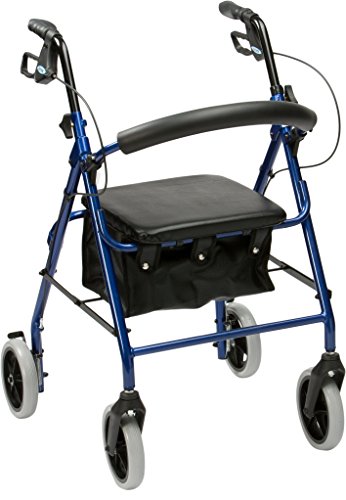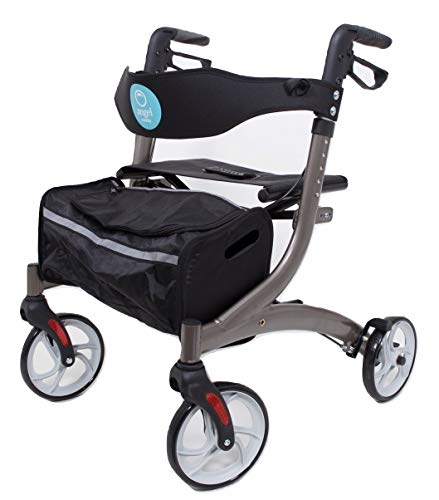The Best Rollator Folding Tips To Make A Difference In Your Life
페이지 정보
작성자 Jett 댓글 0건 조회 4회 작성일 24-11-21 08:55본문
 Locking Mechanism For Use With a Foldable rollator walker for elderly (wayranks.com)
Locking Mechanism For Use With a Foldable rollator walker for elderly (wayranks.com)Most rollators are equipped with locks or locking mechanisms which prevents them from unfolding when in storage. This is essential to avoid a potentially hazardous situation during transportation.
The lock is usually located near the center of the frame. It can be a lever or a button. It is crucial to know how to operate this feature.
How to Fold a Rollator
Rollators are extremely effective mobility aids for those who need support and stability when walking. Rollators are lightweight, practical and come in a variety of models that can be adapted to different budgets and requirements. 1 However, some people might be worried about how to fold and unfold a rollator to use it safely.
Most modern rollators have easy-to-use mechanisms to fold. The walkers rollators can be folded quickly and without the need of any tools. This makes them ideal for storage and transport. Moreover, the locking mechanism ensures that the walker folded will not be able to open during storage or transport which provides security and security to users.
Alongside a simple folding mechanism modern walkers have ergonomic designs that provide safety and comfort to the user. They come with a large basket, comfortable handles, and a brake lever that stops accidental activation. Furthermore, they are made of lightweight materials that ensure portability and ease of handling.
Traditional rollators however are heavier and do not support themselves when folded which makes them difficult to store or transport. Their seats are also connected to the frame which means they cannot be stored against objects or in small spaces. It is crucial that those who use rollators learn how fold them to make it easier for storage and transport.
The first step to fold a rollator involves finding the locking mechanism. This is usually located near the middle of the frame. You can either gently lift it or release it by following the instructions provided by the manufacturer. Once the locking mechanism is removed you can fold the walker by pushing its sides against each and holding the releases. Continue folding the walker until it is tightly locked and compacted.
You should also check your walker to see whether there are any loose parts or signs of wear and damage. Repair any issues as soon as you notice them to prevent further injury or damage. Lastly, it is recommended to regularly oil all terrain rollator moving parts of the walker to minimize friction and ensure the smooth operation.
The Crossbar
The crossbar is the central bar which supports a rollator's frame and wheels. It's usually made of metal and connects the handlebars to the frame's base. The crossbar is designed to provide added strength and stability, and it can also help hold the basket of the walker or other attachments. Many manufacturers offer additional accessories, such as storage baskets and tote bag for their walker models. They can be affixed to the front or back of the walker, or may be placed underneath the seat.
Many models of walker have crossbars that can be folded in two directions. This makes them easier to store and transport. This is a crucial feature, particularly if you plan to use the walker for frequent travels or long trips to the store or other places. Certain models of walker come with a bag that can be used for an additional storage.
The brakes are another important aspect of a walker that is rolling. They are usually located on the handles and crossbar. There are a variety of brakes available, including cable loops and push-down. To stop the walker rolling the user has to apply downward pressure to the spring-loaded frame. This type of system is not suitable for small users who may struggle to engage the breaks or heavier users who could unintentionally activate the brakes.
A cable loop brake system operates similar to the brakes of a bicycle. It is activated by pressing the handlebars and levers at the same time using both hands. This type of brake system provides greater control and is better for those with limited hand function.
Crossbar can also refer to a vertical stroke that crosses two other strokes in a letterform. The length, thickness and position of a crossbar may affect the legibility of a particular letterform, and it's a major distinction between serif and non-serif fonts. The crossbar that is on the small e is commonly called an arm.
The Release Mechanisms
Rollators are a great way to boost mobility and independence for people who have physical limitations. These innovative stability aids redistribute the weight of the user evenly across their lower body, reducing stress on joints and muscles, and allowing for easy and comfortable movement. With features that can be customized, such as handbrakes and adjustable handlebars, built-in seats, and storage compartments, they make it easier for users to navigate their environment with comfort and confidence. In addition, these lightweight and portable mobility aids are usually covered by Medicare or Medicaid to aid in obtaining affordable.
Carbon rollators are simpler to transport and store than traditional walkers. They fold in half and can be put in the trunk. To do this, take off the basket and pull up on the crossbar, which exposes a pair of release mechanisms at each side of the frame. Then, press the release mechanisms and press the frame's sides until the walking device shrinks to its smallest size.
The locking assembly affixes to a top substantially horizontal support arm 218 that joins a pair of substantially vertical tubular legs in the rear and front 220 and 228, respectively. Telescoping tubular leg extension 226 and 228 are respectively releasably attached to the ends of front and rear tubular legs. These telescoping extension can be turned from an unlocked position to a locked position in order to alter the height.
Once the extension leg segments have been positioned in the right position, a nonsliding grip is positioned at the end of actuating lever. The housing is connected to the actuating lever by an extension piece that extends and a recess designed to accept the extension piece. The extension piece as well as the recessive piece provide an axis around which the actuating handle can be rotated.
When the telescoping legs segment are in the correct position, the locking mechanism activates a snap-button as well as a biasing spring. This arrangement allows the user to simply engage or detach the folding mechanism, which allows for a simple storage and transport of the walking aid.
The Locking Mechanism
The present invention relates to a locking mechanism for use with a foldable rollator or walker. The invention solves the need for a lock that can be used for use with walkers and rollators that is easy for those with limited mobility to set up between folded or unfolded positions.
In general, the device consists of two spaced side frames, with the cross brace that connects them. It also includes two handles. Two hand brakes are welded to the handles and each has a pin actuating plunger that engages with the plunger of a cross bar. As the user pushes the hand brakes, the pin-actuating plunger is released, causing the side frame to fold into a position.
One issue that comes with this type of device is that the lever must be held in place by a hand while attempting to depress the plunger actuating pin. This could be a challenge for those with limitations in the strength or dexterity of their hand. The present invention addresses this problem by including the locking assembly functionally connected to the actuating lever.
As illustrated in FIG. 2. The locking assembly consists of a first body portion that has an opening through which extends the locking pin, and a second body portion rigidly connected to the first body. A lock plate is set within the bore and features an aperture that is adapted to receive a locking end of the locking pin. A portion of the actuating mechanism between the handle for force application end and the body attaching end is configured to pivot relative to both of the body parts so that the locking pin can be moved from a fixed position where it blocks the rotation of the tubular leg, and a position where the leg extension telescoping can be extended.
When the actuating handle moves and the locking pin is moved from the initial position to the second position. The leg extensions that telescoping can be pulled back and rotated into their folded position by turning the side frame. This can be done while the user's hand is still firmly gripping the handgrip 24 of the side frame. This feature can significantly reduce the amount of effort required to fold a rollator all terrain wheels in and out of its folded position.

댓글목록
등록된 댓글이 없습니다.